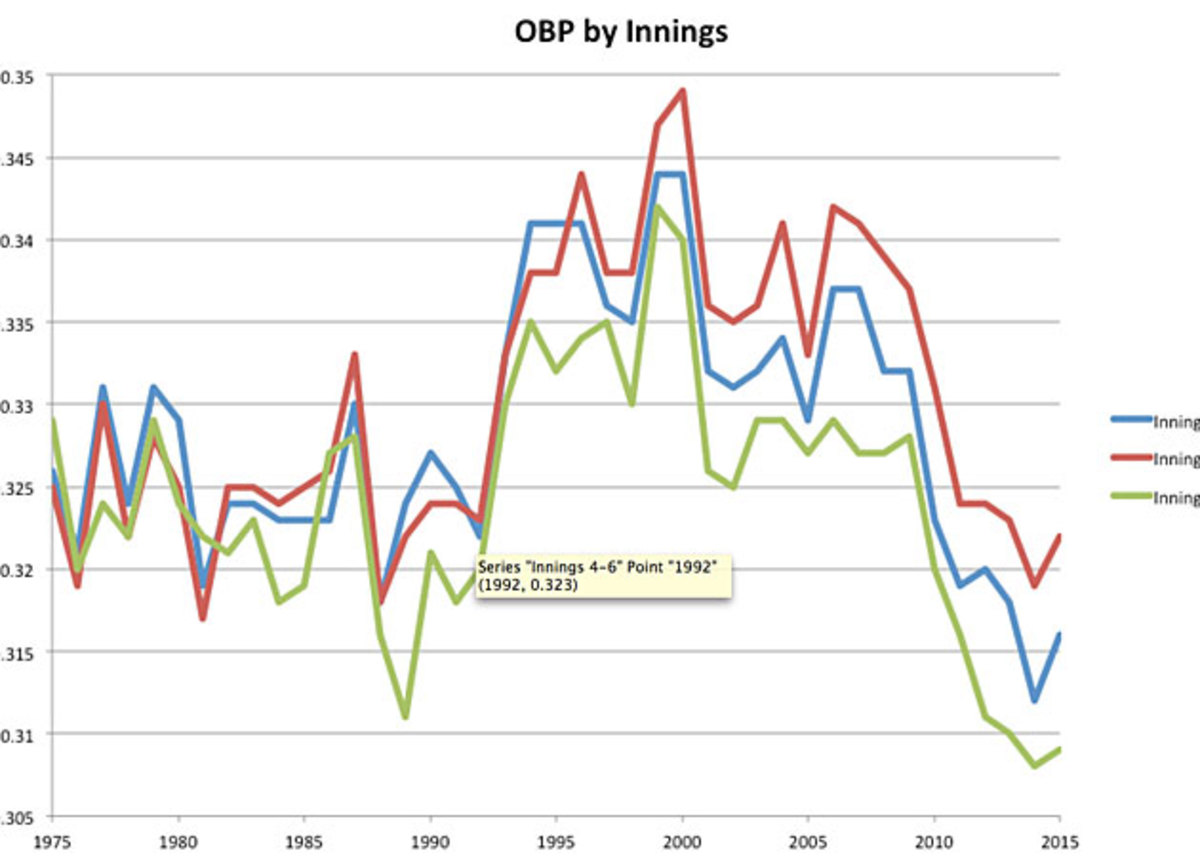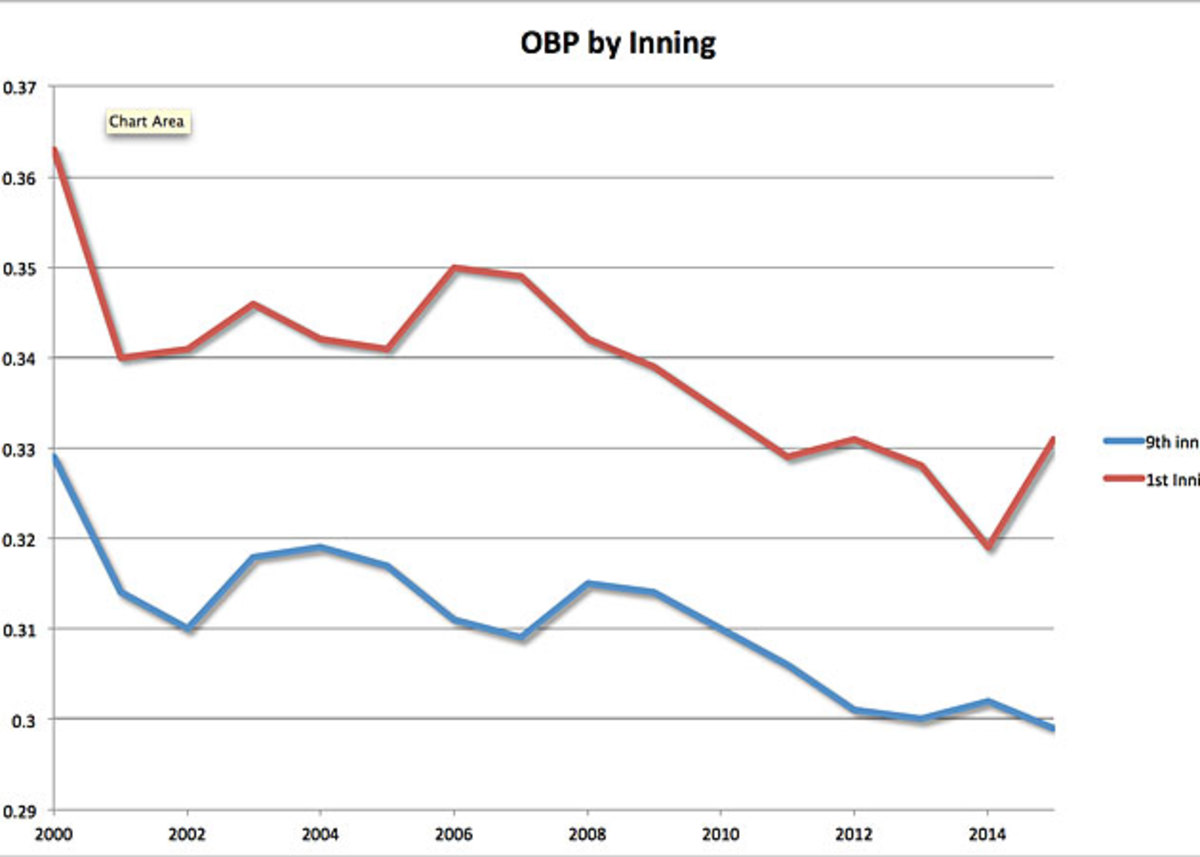Killing the comeback: Dominant bullpens making late rallies rare

Get all of Tom Verducci’s columns as soon as they’re published. Download the new Sports Illustrated app (iOS or Android) and personalize your experience by following your favorite teams and SI writers.
The endgame of the best kind of sports contest is a thrilling denouement. An NFL team works a two-minute drill. An NBA team goes up-tempo. An NHL team puts an extra skater on the ice. And the NCAA men’s basketball championship game is tied and then decided on two three-point shots in the final 4.7 seconds. The roar for Kris Jenkins of Villanova will outlast the man himself.
In baseball, however, commissioner Rob Manfred has an endgame problem. Over the last decade, relief pitching has been draining the excitement out of baseball.
With increasing efficacy, a baseball team squelches late action by running out a series of high-velocity pitchers. Offense dries up. The game stops for pitching changes. The ball is put in play less often. Fewer runners reach base, and the ones that do rarely attempt to steal. In short, relief pitching is killing comebacks.
The team that scored first won more than 70% of major league games last season, the first time that has happened since 1968, which was the nadir of the modern game. Baseball was so boring and so poorly attended that season that within the next five years, the owners adopted two massive rules changes: a lower mound and the designated hitter.
I’ve written before about how specialized relief pitching is taking over the game. There is no sign of letup. Last year, relief pitchers finished more games, struck out more batters and made the most appearances in baseball history. And these guys are good. It has been harder to get on base against relief pitching the past two seasons (.314 OBP in 2014, .315 in '15) than any year except … 1968 (.307).
Despite weather, Opening Day still has plenty of excitement
This run prevention methodology has been in place for about a decade and is brutally efficient. Last year, the Royals won the World Series with a starting staff that threw the fewest innings in the league and had the fourth-worst ERA. State-of-the-art relief pitching carried Kansas City to the championship, as its relievers, anchored by closer Wade Davis, went 8–0 in the postseason with a 2.51 ERA.
Where once the entire American League had one Goose Gossage, the Yankees alone now have three of them: Aroldis Chapman, Andrew Miller and Dellin Betances. Those bullpen mates who have accounted for seven of the top 20 single-season strikeout rates in relief history (min. 50 games).
But now I wonder: Is what’s good for holding a lead and shutting down offense late in games good for baseball and its appeal? No matter your age, the end of a baseball game today is very different from what you knew growing up. Using data from baseball-reference.com, I wanted to see just how much the endgame has changed. How different are the last three innings of a game in this decade of monster bullpens?
Take a look at the answer in graph form: on-base percentage since 1975 as measured in thirds of a game—the first three innings (represented in blue), middle three innings (red) and last three innings (green):

What stands out is the growing space between the three trend lines in the last decade. What were cracks and crevices for four decades have become chasms of white space. It looks like three strands of Christmas lights getting untangled. Here’s the quick translation: How baseball looks in the last three innings is becoming more different from the rest of the game.
In 1975—and this sounds incredible now—it actually was slightly easier to get on base in the last three innings than in the first three or middle three. That sort of uptick in late offense happened again in 1981, a strike year. It hasn’t happened since then, but for three decades, the game looked rather similar at the end as it did in the beginning and middle.
• Subscribe to get the best of Sports Illustrated delivered right to your inbox
And then in 2006, the pitching revolution began to take hold. Steroid testing began in 2004, but this revolution is far bigger than to be explained away by that simple default answer. Pitching is a much easier skill to teach and develop than hitting, a reactionary pursuit with many more variables. As video became cheaper and more ubiquitous (facilitating instruction), and as a generation discovered that velocity can be a learned skill rather than God-given, and as the radar gun began to drive college recruiting and pro scouting, hard-throwing pitchers flooded the amateur and pro market. Pitching, with its repeatable movements and controlled environment, is the perfect endeavor in what has become our culture of specialization.
Even as the rise in velocity contributed to a rise in Tommy John surgeries, the swelling supply of hard throwers permitted all teams to build deep bullpens that allow managers to match up against hitters and to limit how often relievers are exposed. This is the formula that now rules the day: power in short bursts done often by many pitchers.
Red Sox lead teams that look like best bets to surprise in 2016
Another takeaway from the above chart, this time in numerical form: In three decades starting in 1975, only two times did the OBP gap between the highest cluster of innings (usually the middle three) and the seventh-through-ninth cluster exceed .010. But in just the last decade it has happened eight times, including each of the past four years. Here are the three toughest seasons since 1975 for getting on base late in a game: 2014 (.308), '15 (.309) and '13 (.310). See a pattern here?
As you might have guessed, the ninth inning, often left for the team’s most powerful arm to sometimes face the bottom of a lineup, is the most acute form of this offensive wasteland. The ninth inning last season featured the worst OBP (.299), the lowest WHIP (1.203), the highest strikeout-to-walk rate (3.11), the second-lowest batting average (.233, behind 2012) and the third most strikeouts (behind '12 and '14) in recorded history.
Why should we care? Isn’t there drama in seeing a closer strike out three guys with the game on the line in the ninth inning? Sure, especially to the baseball aficionado. The question here is this: Is it bad for the game’s broad appeal that monster bullpens keep the ball out of play, keep runners off base and depress comebacks?
Sports are about moments. Games fade, but moments last forever. You remember the home run by Kirk Gibson in 1988, but maybe not the rest of that World Series. Francisco Cabrera is forever a legend in Atlanta. From Bobby Thomson to Alan Ameche to Bobby Orr to Michael Jordan to Kris Jenkins, late offense drives the enduring oral history of team sport.
Five years ago, Bob Costas and I hosted Baseball’s Greatest Games on MLB Network. Game after game chosen for the series was defined by late offense. Tell me the historically great game in which a team jumped to an early lead, and held it as four relief pitchers took care of the last dozen outs; I won’t wait.
Maybe baseball is headed toward an offensive upswing. Home runs jumped last year by the biggest percentage since 1993. Rookies hit more home runs than ever before. Offense surged in August and September. But little of that surge showed up late in games. The team that scores first is winning games at a rate not seen since modern baseball was at its worst. And the ninth inning … well, as you can see below in comparing how games begin and end, you won’t find any of that upswing at crunch time.

